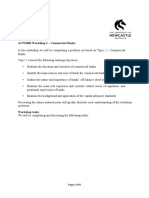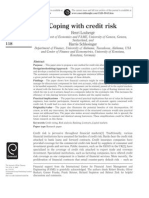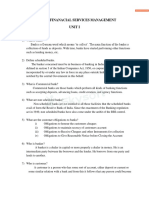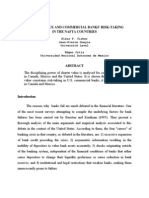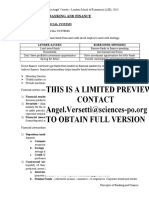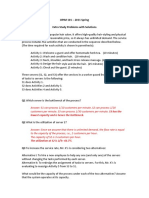2017 PBF Mock
2017 PBF Mock
Uploaded by
Bryan SingCopyright:
Available Formats
2017 PBF Mock
2017 PBF Mock
Uploaded by
Bryan SingOriginal Description:
Copyright
Available Formats
Share this document
Did you find this document useful?
Is this content inappropriate?
Copyright:
Available Formats
2017 PBF Mock
2017 PBF Mock
Uploaded by
Bryan SingCopyright:
Available Formats
SINGAPORE INSTITUTE OF MANAGEMENT
UNIVERSITY OF LONDON
PRELIMINARY EXAM 2017
MARKING GUIDE
PROGRAMME : University of London Degree and Diploma Programmes
MODULE CODE : FN1024
MODULE TITLE : Principles of Banking and Finance
SECTION A
Answer one question from this section and not more than a further two questions. You
are reminded that four questions in total are to be attempted with at least one question
from Section B.
1. (a) Discuss the main functions of a financial system and explain why these are
important for an economy. (13 marks)
The main functions of financial systems are to:
provide the mechanisms by which funds can be transferred from units
in surplus to units with a shortage of funds in order to directly or
indirectly facilitate lending and borrowing
enable wealth holders to adjust the composition of their portfolios
provide payment mechanisms
provide mechanisms for risk transfer
Looking for a discussion of these functions such that the second part of the question is
answered following points expected:
FN1024 Principles of Banking and Finance 1
(i) mobilize savings
(ii) increase funds available to fund capital investments
(iii) increase efficiency of economic activity
(b) Compare and contrast the relative importance of banks and securities markets in the
USA and Germany. (12 marks)
Bank based Germany and Japan
Market based US and UK
Comparison based on the following criteria:
(1) Integration of banking and commerce
Either by banks ownership of firms equity or firms ownership of bank equity and the
influence these bring.
Bank based systems close integration (Keiretsu in Japan and Hausbank system in
Germany). Helps with reducing asymmetric information problems.
Market based systems not a close relationship. In some market-based systems equity
stakes prohibited.
(2) Integration of banking and non-bank financial services.
In bank based systems such as Germany the banks are Universal banks supplying a wide
range of services to firms e.g. traditional banking, underwriting, advisory etc. Firms then
deal with one bank (or closely connected group) for all their services.
In market based systems firms will often obtain different financial services from different
banks. In US the integration of traditional banking and other financial services was
restricted until the repeal of Glass-Steagall.
(3) Household asset allocation
In market based systems where equity markets are more important, equity holdings by
householders form a larger part of total wealth. Cash and cash equivalent (e.g. bank
deposits) form a lower proportion of total wealth in market based systems.
(4) Importance of pension funds
FN1024 Principles of Banking and Finance 2
Holdings of assets through pension funds more important in market based systems such
as UK and US where private provision (rather than state provision) of pensions more
important.
(5) Firms financing
In bank based systems the proportion of new finance raised by firms from banks is much
higher than from capital markets.
2. Discuss the various theories proposed to explain the existence of financial
intermediaries. (25 marks)
Covered throughout chapter 4 of the subject guide.
Would expect as a minimum discussion of asset transformation, transaction costs and
asymmetric information.
Better answers would also cover liquidity insurance, informational economies of scale
and delegated monitoring.
The best answers would discuss the extent to which the different theories help us explain
why indirect finance is preferred over direct finance.
3. (a) Discuss the arguments in favour of free (unregulated) banking.
(12 marks)
Free (unregulated) banking refers to banking without oversight by a regulator.
Regulation by the market instead. The market refers to the providers of finance and other
customers of the bank. So depositors will choose where to place deposit and so will force
banks to move along the risk spectrum to satisfy the preferences of the majority of
depositors.
Arguments in favour:
(1) Lower cost no regulator compliance cots
(2) More disclosure as system more dependent on disclosure to work
(3) Higher levels of capital held capital becomes the signalling device indicating safety.
(4) More efficient (lower cost/better management) as weak banks will fail as there is no
regulator to rescue poorly managed banks
FN1024 Principles of Banking and Finance 3
(5) Lower moral hazard as the existence of a regulator generally reduces the incentive of
depositors to monitor and increases the risks taken by banks as the downside of risk is
lessened by potential bailout.
However all these arguments in favour need to be set against the main problem with free
banking which is greater systemic risk as there is no regulator (or deposit insurance
scheme) to protect against contagion effects. Hence most countries have regulated
banking systems.
(b) Discuss the differences between micro-prudential regulation and macro-prudential
regulation and give examples of the tools/techniques used in each. (13 marks)
See subject guide, chapter 5, section on Macro-prudential policy
Micro-prudential regulation this is concerned with preventing the failure of individual
banks through capital adequacy, supervision etc. It aims to prevent systemic failure by
preventing individual bank failure leading to contagion effects.
Macro-prudential regulation, in contrast, aims to identify and reduce the build up of
systemic risk e.g. common exposures to price bubbles, interconnectedness etc.
Macro-prudential regulation has been given more emphasis since the 2008 crisis as the
previous micro approach failed to prevent the crisis i.e. failed to prevent the build up of
systemic risk.
4. (a) Explain the following risks faced by banks:
(i) credit risk
(ii) liquidity risk
(iii) market risk
(iv) operational risk
(8 marks)
refer to pp.10205 of the subject guide.
This is a straightforward question with two marks allocated to each risk explained.
Credit risk is the risk of default on loans and other debt securities. This is the main risk
faced by traditional (commercial) banks as loans are generally the main asset held by
the bank. It is affected by the economic cycle with defaults likely to increase as the
economy goes into recession.
Liquidity risk is a consequence of bank having liabilities that have a significantly shorter
maturity than their loans. In particular many liabilities are demand deposits that are
repayable on demand. If confidence in a bank reduces suddenly many depositors may
FN1024 Principles of Banking and Finance 4
rush to withdraw their deposit. However banks do not have sufficient assets in liquid
form to meet large numbers of withdrawals.
Market risk is the risk arising from changes in market determined rates of interest/prices
that affect the value of assets in the trading book. Assets held in the trading book are
those held for short periods in expectation of making a profit. Has become a bigger
problem in last decade as large banks massively increased their trading books. MBSs
and CDOs are held in trading books as well as commodities, other types of bonds etc.
Operational risk is the risk arising from poor operating procedures, systems and people.
Became an issue after the collapse of Barings. Difficult to measure but now
incorporated into Basel 2 regime with its own capital requirement.
(b) Discuss the techniques banks can use to manage credit risk. (12 marks)
The main techniques for managing credit risk are:
screening
pooling
diversification
collateral and endorsement
restrictive covenants.
Satisfactory answers would explain each of these techniques. Better answers would
discuss the impact of each of these techniques on the various causes of credit risk such
as moral hazard and adverse selection. So, for example, adverse selection is best
addressed by screening techniques. Moral hazard is addressed by restrictive covenants.
(c) Distinguish between refinancing and reinvestment risk as faced by banks. Give
examples of each of these types of risk. (5 marks)
These risks relate to the income effect of interest rate risk.
Refinancing risk is the risk that the cost of re-borrowing funds will be higher than the
returns earned on asset investments.
Re-investment risk is the risk that the returns on funds to be reinvested will be lower than
the cost of funds.
Better answers would provide an example of each of these risks in relation to banking.
FN1024 Principles of Banking and Finance 5
SECTION B
Answer one question from this section and not more than a further two questions. You
are reminded that four questions in total are to be attempted with at least one question
from Section A.
5. (a) Consider the following projects (X and Y):
Expected Cash flows (000s)
Project C0 C1 C2
X -1900 1300 900
Y -1900 0 2,100
Assuming an opportunity cost of capital of 10%, what is the NPV of the two projects?
Which project(s) would you accept? (5 marks)
Assuming an opportunity cost of capital of 10%, what is the NPV of the two
projects? Which project(s) would you accept? (5 marks)
NPV(X) = -1900 +1300/(1.1) + 900/(1.1)2 = 25.62 (or 25,620) (2 marks)
NPV(Y) = -1900 + 2100/(1.1)2 = -164.46 (or -164,460) (2 marks)
Therefore ACCEPT X and REJECT Y (1 mark)
(b) Calculate the IRR for project X and Y. Which project(s) would you accept given a
hurdle rate equal to the opportunity cost of capital? (6 marks)
For project X, when i=10%, NPV = 25.62
When i=15%, NPV = -89.04
Interpolating: IRR = 10 + [25.62 / (25.62+89.04)] *(15-10) = 11.12%
IRR > hurdle rate ACCEPT (3 marks)
For project Y
When i=10%, NPV=-164.6
When i=5%, NPV = 4.76
Interpolating IRR = 5 + [4.76/(4.76+164.6)]*(10-5) = 5.16%
IRR < hurdle rate REJECT
FN1024 Principles of Banking and Finance 6
(c) Explain the additivity property of the NPV method and explain why this property
makes the NPV method useful for investment appraisal when funds are limited.
(7 marks)
See subject guide page 125
(d) Discuss the reinvestment assumptions of the NPV and IRR methods.
(7 marks)
See subject guide page 127
6. (a) Calculate the price and Macauley duration of the following two bonds. Note that
both bonds pay annual coupons, have par values of 100 and the current market
interest rate is 8%
Maturity Coupon
Bond A 7 years 3%
Bond B 4 years 10%
(7 marks)
A B DF CF_A*DF CF_B*DF CF_A*DF*t CF_B*DF*t
1 3 10 0.9259 2.7777 9.259 2.7777 9.259
2 3 10 0.8573 2.5719 8.573 5.1438 17.146
3 3 10 0.7938 2.3814 7.938 7.1442 23.814
4 3 110 0.735 2.205 80.85 8.82 323.4
5 3 0.6806 2.0418 10.209
6 3 0.6302 1.8906 11.3436
7 103 0.5835 60.1005 420.7035
73.9689 106.62 466.1418 373.619
PA = 73.97 Dur_A = 6.301862
years
PB = 106.62
Dur_B = 3.504211
years
(b) Use the modified duration formula to estimate the % change in price of bond A and
bond B if interest rates were to rise by 1%. (4 marks)
FN1024 Principles of Banking and Finance 7
Mod D_A= -D/(1+i) = -D/(1+-0.08) = -6.30/(1.08) - 05833
Mod D_B= -D/(1+i) = -D/(1+-0.08) = -3.50/(1.08) -0.03241
Mod Dur_A = -5.833% (2 marks), Mod Dur_B = -3.24% (2 marks)
Note answers should be in % terms and negative to get the full marks
(c) For an investor looking for the lowest risk of capital loss on their investment which
bond would you recommend? (3 marks)
From our modified duration calculation:
The fall in price of bond A for a 1% increase in interest rates is greater than the fall in
price of bond B.
Also the duration of bond A is greater than he duration of bond B so bond A is more
interest rate sensitive.
So risk averse investors should choose bond B.
(d) Explain, using an appropriate diagram, why the modified duration formula only
provides an estimate of the interest rate sensitivity of a bond. (4 marks)
The bigger the change in interest rate the greater the inaccuracy because of the implicit
assumption that the relationship between P and i is linear when in fact it is convex.
FN1024 Principles of Banking and Finance 8
(e) Explain the relationship between Macauley duration and bond maturity, bond
coupon rate and the market rate of interest. (7 marks)
The three relationships are covered on the bottom of page 113 and top of page 114 in the
subject guide.
Note 3 marks for describing the 3 relationships. 4 marks for explaining them.
Note : Macaulay duration = P = PVt * t / PVt
where PVt = present value of cash flow at t = CFt * DFt
(i) Macaulay duration and bond maturity are positively related.
Macaulay duration is a weighted average of the maturities of the cash flows.
So increasing the maturity of the bond increases the weighted average of the cash flows
and hence Macaulay duration.
(ii) Macaulay duration and bond coupon rate are positively related.
Increasing the early cash flows (coupons) gives more weight to the earlier maturities (t)
(iii) Macaulay duration and market rate of interest are negatively related.
Increasing the market rate of interest will reduce the weights (cash flows) and because the
discount factor is raised to a power the weights are reduced more for later cash flows.
Hence duration falls.
7. (a) Briefly explain each of the following terms:
(i) minimum variance portfolio
This is the portfolio with the lowest variance and is the turning point on the mean
variance frontier. Formula gets an extra mark.
(ii) efficient frontier
These are the points on the mean variance frontier that are the most efficient in the
sense that they deliver the highest return for a given variance.
(iii) unsystematic risk
This is the risk associated with a specific asset and can be diversified away by
combining the asset with others.
(iv) market risk premium
FN1024 Principles of Banking and Finance 9
This is the return for bearing market risk in the CAPM framework. It is the return on
the market less the risk free rate.
(8 marks)
(b) Explain how a change in the correlation between the returns on two stocks effects
the mean standard deviation frontier for the two stocks. (6 marks)
As correlation reduces the mean variance frontier is pulled to the left and away from
being a linear relationship. A correlation of +1 gives a linear relationship.
(c) You are given the following information:
(i) A stock with a beta of 0 has an expected return of 6%.
(ii) A portfolio made up of 50% invested at the risk free rate and 50%
invested in the market portfolio has an expected return of 9%
What is the expected return on the market portfolio? (4 marks)
Expected return on risk free asset = 6%
Expected return on portfolio described in (ii) = 9% = 0.5*6 + 0.5*E(Rm)
Expected return on the market = E(Rm) = 12%
(d) Explain the essential differences between the Capital Asset Pricing Model and
Arbitrage Pricing Theory. (7 marks)
The CAPM is effectively a one factor model. It is theoretically derived but is difficult to
test as has unobservable variables e.g. return on the market. APT is a model that based on
a general factor model with the assumption of no arbitrage opportunities. There are no
unobservable variables but there is no theory to guide the variables to include.
8. (a) Explain what a yield curve for government bonds is and discuss the main theories
for explaining the shape of a yield curve. (12 marks)
See subject guide, chapter 2, section on The term structure of interest rates
The term to maturity influences the interest rate. Bonds with identical risk may have
different yields (interest rates) because of the difference in the time remaining to
maturity. A yield curve plots the yields (interest rates) of bonds with different maturity
but the same risk. The yield curve can be: upward (the long-term rates are above the
short-term rates); flat (short- and long-term interest rates are the same); and inverted
(long-term interest rates are below short-term interest rates).
There are a number of theories that attempt to explain the shape of the yield curve.
(a) Expectations theory
FN1024 Principles of Banking and Finance 10
The expectations theory of the term structure of interest rates states that in equilibrium,
the long-term rate is a geometric average of todays short- term rate and expected short-
term rates in the future.
In this theory, if the current long rate is higher than the current short rate, short-term rates
must be expected to rise in the future. Conversely, if the current long rate is lower than
the current short rate then short-term rates are expected to decline in the future: in this
instance, we will observe a downward sloping yield curve. Finally, if no change is
expected in short rates, then the current long rate will equal the current short rate, and we
will observe a flat yield curve. Hence, the shape of the yield curve will be determined by
expectations of future interest rates.
(b) Liquidity premium theory
Liquidity premium theory asserts that, in a world of uncertainty, investors and lenders
will want to hold assets that can be converted into cash quickly. Therefore they will
demand a liquidity premium for holding long- term debt. Conversely, the same dislike for
uncertainty causes borrowers (for example, firms and governments) to prefer to borrow
for a longer period at a rate which is certain now therefore they will be willing to pay a
liquidity premium and, therefore, a higher rate of interest on their longer-term debt. This
implies that the yield curve will normally be upward sloping, in the absence of any other
influences. In reality, we need to consider the combined effect of expectations together
with liquidity preference. A downward sloping yield curve will occur when expectations
of an interest rate fall are sufficient to offset the liquidity premium.
(c) Market segmentation
As well as the investors expectations with respect to future interest rates and their
preferences for liquidity, another theory, the market segmentation theory, suggests that
the bond market is actually made up of a number of separate markets distinguished by
time to maturity, each with their own supply and demand conditions. Different classes of
investors and issuers will have a strong preference for certain segments of the yield curve
and, therefore, the curve will not necessarily move up, or down, over its entire range.
The test of a theory is (i) does it give us the different observed shapes for a yield curve
(e.g. upward sloping, downward sloping flat etc) and (ii) does it explain why the upward
sloping curve is more frequently observed.
All three can pass test (i) but liquidity preference is better for (ii)
(a) Discuss the problems of valuing common stocks compared to bonds.
(6 marks)
See pp.13135 of the subject guide.
Both types of securities are valued using the formula for calculating the present value of
FN1024 Principles of Banking and Finance 11
future benefits. For common stock there is a problem of the uncertainty of future benefits.
This is because the dividends are unknown and the life of the stock is infinite. We have to
make assumptions about the future benefits (dividends). This could be an assumption of
constant growth of dividends or zero growth. Clearly these assumptions may not be
realistic for the firm being valued.
In contrast, bonds have known future cash flows coupons and par value. The dates of
these cash flows are also known with certainty.
Better answers would note that due to the higher uncertainty of future cash flows for
stocks a higher discount rate (hence a higher required return) is used in the present value
calculation.
(c) Ramada is a company that has patent rights for a new technology that is expected
to enable it to generate growth in earnings and dividends of 15% for the next 3
years. After that (from the start of year 4) the company expects to see earnings and
dividends growth drop to a constant rate of 4%. Assume that investors require a rate
of return of 8% and the last dividend payment made by the company was $2.40.
Calculate an estimate of the current share price for Ramada. (7 marks)
The present value of future dividends is used for valuing this stock. We cannot use the
constant growth (Gordon growth) model from the outset, as dividends do not grow at a
constant rate until the start of year 4. So the first three terms of the model used are simply
the present values of the first three years dividend payments. The final term of the model
is the Gordon growth model that gives us the price of the stock at the end of year 3 (i.e.
based on dividends from year 4 to infinity). The price of the stock at the end of year 3 is
discounted back to its value in year 0.
P = 2.4*1.15/(1.08) + 2.4*1.152/(1.08)2 + 2.4*1.153/(1.08)3 + [2.4*1.154/(0.08-0.04)]
/(1.08)3
P = $91.48
FN1024 Principles of Banking and Finance 12
You might also like
- Friendly Loan AgreementDocument5 pagesFriendly Loan Agreement7 Rings0% (1)
- RSK4804 Mayjun Exam 2023Document12 pagesRSK4804 Mayjun Exam 2023bradley.malachiclark11No ratings yet
- Solution Manual For Bank Management, 7th Edition - Timothy W. KochDocument7 pagesSolution Manual For Bank Management, 7th Edition - Timothy W. KochSamiun TinyNo ratings yet
- Bionic Turtle FRM Practice Questions P1.T3. Financial Markets and Products Chapter 1. BanksDocument14 pagesBionic Turtle FRM Practice Questions P1.T3. Financial Markets and Products Chapter 1. BanksChristian Rey Magtibay100% (1)
- Financial Markets Case Study With AnswersDocument2 pagesFinancial Markets Case Study With AnswersShashi Kumar C G83% (12)
- Career Management Planning WorkbookDocument32 pagesCareer Management Planning WorkbookBryan Sing100% (3)
- Chapter Xvii Decisions Involving Alternative Choices SolutionsDocument6 pagesChapter Xvii Decisions Involving Alternative Choices Solutionsshital_vyas1987No ratings yet
- Dell Working CapitalDocument6 pagesDell Working CapitalNavi Spl50% (2)
- FINA 385 Theory of Finance I Tutorials CAPMDocument17 pagesFINA 385 Theory of Finance I Tutorials CAPMgradesaverNo ratings yet
- ACFI1003 Workshop 2 QuestionsDocument6 pagesACFI1003 Workshop 2 Questions王亚琪No ratings yet
- Unit-3 Banking and Insurance ManagementDocument21 pagesUnit-3 Banking and Insurance ManagementChandra sekhar VallepuNo ratings yet
- Solution For Mini Exam 4Document3 pagesSolution For Mini Exam 4EdNo ratings yet
- IMCh 01Document12 pagesIMCh 01Maksad IshbaevNo ratings yet
- Basel PDFDocument23 pagesBasel PDFPabitra DebnathNo ratings yet
- Advanced Finance, Banking and Insurance SamenvattingDocument50 pagesAdvanced Finance, Banking and Insurance SamenvattingLisa TielemanNo ratings yet
- Bài Tập Và Đáp Án Chương 1Document9 pagesBài Tập Và Đáp Án Chương 1nguyenductaiNo ratings yet
- Test 4for Students - Topic 4Document5 pagesTest 4for Students - Topic 4Yến NguyễnNo ratings yet
- Asset Liability Management An Indian PerspectiveDocument4 pagesAsset Liability Management An Indian PerspectivedhanendrapardhiNo ratings yet
- Asset Liability Management An Indian PerspectiveDocument4 pagesAsset Liability Management An Indian PerspectivedhanendrapardhiNo ratings yet
- Vorlesung-Ws10 - Teil 1 PDFDocument66 pagesVorlesung-Ws10 - Teil 1 PDFFrédéric BlaisNo ratings yet
- FN2029 - FI - 2011 Examiners Commentaries - Zone-BDocument8 pagesFN2029 - FI - 2011 Examiners Commentaries - Zone-BScarlett Ford GeronimoNo ratings yet
- B3 - Additonal Question BankDocument124 pagesB3 - Additonal Question BankXY ZWQNo ratings yet
- Bank Capital RegulationDocument57 pagesBank Capital RegulationAshenafiNo ratings yet
- Financial Markets - Products-1Document470 pagesFinancial Markets - Products-1Heet Gandhi100% (1)
- Chapter 2 Financial Institutions, Financial Intermediaries, and Asset Management FirmsDocument19 pagesChapter 2 Financial Institutions, Financial Intermediaries, and Asset Management FirmsDavid GreyNo ratings yet
- Chapter 4Document6 pagesChapter 4Tamara TopicNo ratings yet
- Credit Risk ManagementDocument63 pagesCredit Risk ManagementNagireddy KalluriNo ratings yet
- Submission 3 PDFDocument9 pagesSubmission 3 PDFsadiqpmpNo ratings yet
- Bank Capital RegulationDocument46 pagesBank Capital RegulationMuhammed AyonNo ratings yet
- Risk Management in BanksDocument47 pagesRisk Management in BankshitkarkhannaNo ratings yet
- YhjhtyfyhfghfhfhfjhgDocument7 pagesYhjhtyfyhfghfhfhfjhgbabylovelylovelyNo ratings yet
- BSF 3202 - Financial Institutions and Markets - November 2019Document4 pagesBSF 3202 - Financial Institutions and Markets - November 2019Ian MunyingiNo ratings yet
- Why Banks Are Regulated: To Ensure That Markets Work EfficientlyDocument6 pagesWhy Banks Are Regulated: To Ensure That Markets Work EfficientlyAhmad QuNo ratings yet
- Fabbozi Chapter 2 TestDocument15 pagesFabbozi Chapter 2 TestEuromina Thevenin50% (2)
- Final Exam Money and Banking - Representative QuestionsDocument12 pagesFinal Exam Money and Banking - Representative QuestionsSeba BustoNo ratings yet
- FRM Test 17Document19 pagesFRM Test 17Kamal Bhatia100% (1)
- Occasional Paper Series: The Use of Portfolio Credit Risk Models in Central BanksDocument45 pagesOccasional Paper Series: The Use of Portfolio Credit Risk Models in Central BanksDejChonlateeNo ratings yet
- Tutorial Solution Week 5Document4 pagesTutorial Solution Week 5Angelyn Soh100% (1)
- Margin For Uncleared Presentation FINALDocument21 pagesMargin For Uncleared Presentation FINALMarketsWikiNo ratings yet
- Chapter-I Introduction and Design of The StudyDocument28 pagesChapter-I Introduction and Design of The StudyShabreen SultanaNo ratings yet
- A Neural Network Approach For Credit Risk Evaluation: Author's A LiationDocument22 pagesA Neural Network Approach For Credit Risk Evaluation: Author's A LiationSaiNo ratings yet
- FN2029 - FI - 2010 Examiners Commentaries - Zone-BDocument8 pagesFN2029 - FI - 2010 Examiners Commentaries - Zone-BScarlett Ford GeronimoNo ratings yet
- Coping - With Credit RiskDocument17 pagesCoping - With Credit RiskShatarupa MitraNo ratings yet
- Banking Finanacial Services Management Unit I: Two Mark QuestionsDocument21 pagesBanking Finanacial Services Management Unit I: Two Mark QuestionsIndhuja MNo ratings yet
- MGT411 SbjsolbylaibabuttDocument9 pagesMGT411 Sbjsolbylaibabutttina kaifNo ratings yet
- 2016 - 01Document9 pages2016 - 01Bích ChâuNo ratings yet
- Essays UOLs FIDocument34 pagesEssays UOLs FIAnna KucherukNo ratings yet
- Case Study 2Document17 pagesCase Study 2hilmi zoolNo ratings yet
- Basel - I, II, IIIDocument23 pagesBasel - I, II, IIISangram PandaNo ratings yet
- Charter Value and Commercial Banks' Risk-Taking in The Nafta CountriesDocument19 pagesCharter Value and Commercial Banks' Risk-Taking in The Nafta CountriesNovi_Hendra_Sa_4838No ratings yet
- Mid-Term Test 2023.without AnswerDocument10 pagesMid-Term Test 2023.without AnswerĐạt Tạ QuốcNo ratings yet
- P20BDocument9 pagesP20Bkumawatheena2002No ratings yet
- The Evolution To Basel IIDocument34 pagesThe Evolution To Basel IIShakila ParvinNo ratings yet
- Chapter 5 PDFDocument25 pagesChapter 5 PDFAA BB MMNo ratings yet
- FINS1612 Tutorial 2 - BanksDocument5 pagesFINS1612 Tutorial 2 - BanksRuben CollinsNo ratings yet
- Report 19 PDFDocument52 pagesReport 19 PDFAnshuman DasNo ratings yet
- Trial Exam Spring 2017Document3 pagesTrial Exam Spring 2017Mega Pop LockerNo ratings yet
- Test 4Document4 pagesTest 4Dương Thu HàNo ratings yet
- Basel 3 PPT OfficialDocument32 pagesBasel 3 PPT OfficialNEERAJA N JNo ratings yet
- Essay FinanceDocument8 pagesEssay FinanceEmmanuelMicheNo ratings yet
- World 2... CzechDocument8 pagesWorld 2... CzechzemeNo ratings yet
- Advanced Finance Banking and Insurance Questions and Model Answers Exam 13 December 2018Document2 pagesAdvanced Finance Banking and Insurance Questions and Model Answers Exam 13 December 2018Melanie VanNo ratings yet
- FRM Part I Mock Exam 02 F4U Center 28.4.2019 PDFDocument32 pagesFRM Part I Mock Exam 02 F4U Center 28.4.2019 PDFADAMS zequiNo ratings yet
- Banking in Crisis: How strategic trends will change the banking business of the futureFrom EverandBanking in Crisis: How strategic trends will change the banking business of the futureNo ratings yet
- Bank Asset and Liability Management: Strategy, Trading, AnalysisFrom EverandBank Asset and Liability Management: Strategy, Trading, AnalysisNo ratings yet
- Balance Sheet Movements: Asset IncreaseDocument1 pageBalance Sheet Movements: Asset IncreaseBryan SingNo ratings yet
- EC1002 Examiner CommentariesDocument17 pagesEC1002 Examiner CommentariesBryan Sing100% (1)
- Sim Investment & Networking: Committee Member Application 2016Document7 pagesSim Investment & Networking: Committee Member Application 2016Bryan SingNo ratings yet
- LSE Notes Principles of Banking and Fina PDFDocument4 pagesLSE Notes Principles of Banking and Fina PDFBryan SingNo ratings yet
- NUS Economics Alumni MentorshipDocument4 pagesNUS Economics Alumni MentorshipBryan SingNo ratings yet
- Pre-Application Checklist: 1. Technical Requirements 2. A Valid Email AccountDocument2 pagesPre-Application Checklist: 1. Technical Requirements 2. A Valid Email AccountBryan SingNo ratings yet
- Khea Mu Acctg Feb2015Document12 pagesKhea Mu Acctg Feb2015Bryan SingNo ratings yet
- Sub-Committee Application Form 2016: Preferred Department)Document4 pagesSub-Committee Application Form 2016: Preferred Department)Bryan SingNo ratings yet
- SIM Accounting Association Sub-Committee Recruitment Drive: 1 To 12 August 2016Document18 pagesSIM Accounting Association Sub-Committee Recruitment Drive: 1 To 12 August 2016Bryan SingNo ratings yet
- Business: Joint DegreesDocument24 pagesBusiness: Joint DegreesBryan SingNo ratings yet
- 2009-Management Accounting Main EQP and CommentariesDocument53 pages2009-Management Accounting Main EQP and CommentariesBryan Sing100% (1)
- Bachelor of Science (Honours) : Accounting Accounting and FinanceDocument12 pagesBachelor of Science (Honours) : Accounting Accounting and FinanceBryan SingNo ratings yet
- KHEA RHUL BrochureDocument12 pagesKHEA RHUL BrochureBryan SingNo ratings yet
- 2009-Financial Reporting Main EQP and CommentariesDocument46 pages2009-Financial Reporting Main EQP and CommentariesBryan SingNo ratings yet
- LSE Notes Principles of Banking and Fina PDFDocument4 pagesLSE Notes Principles of Banking and Fina PDFBryan SingNo ratings yet
- OPIM101 - Spring 2012 - Extra Study Problems With Solutions PDFDocument17 pagesOPIM101 - Spring 2012 - Extra Study Problems With Solutions PDFjoe91bmw100% (1)
- Essay BankDocument6 pagesEssay Bankkbmbwubaf100% (2)
- 2 PDFDocument11 pages2 PDFAkshay PawarNo ratings yet
- Tcs Email Writing Set 2Document3 pagesTcs Email Writing Set 2anil kumarNo ratings yet
- Letter From Comptroller March Gallagher To Board of EthicsDocument62 pagesLetter From Comptroller March Gallagher To Board of EthicsDaily FreemanNo ratings yet
- Cross River State Hospital PPP ProjectDocument14 pagesCross River State Hospital PPP ProjectKenneth Awoonor-RennerNo ratings yet
- Topic 59 Spot, Forward, and Par Rates - AnswersDocument11 pagesTopic 59 Spot, Forward, and Par Rates - AnswersSoumava PalNo ratings yet
- Defence Accounts Department Office Manual Part-Vi Vol-I Prinipal Controller of Accounts (Fys)Document214 pagesDefence Accounts Department Office Manual Part-Vi Vol-I Prinipal Controller of Accounts (Fys)Vikas BhaduNo ratings yet
- Literature Review For Financial Globalization and Its Impact On Economic GrowthDocument12 pagesLiterature Review For Financial Globalization and Its Impact On Economic GrowthdaduNo ratings yet
- Promoter ShareholdingDocument144 pagesPromoter Shareholdingravikm123No ratings yet
- Soal Ch. 15Document6 pagesSoal Ch. 15Kyle KuroNo ratings yet
- Indo German Carbons - R - 22052018Document7 pagesIndo German Carbons - R - 22052018Vinu VaviNo ratings yet
- The Richest Man in Babylon Book Summary: The Seven Cures For A Lean PurseDocument5 pagesThe Richest Man in Babylon Book Summary: The Seven Cures For A Lean PurseZainab SyedaNo ratings yet
- CGS 1 WFH Accomplishment Report November 2022 - ATMDomantayDocument2 pagesCGS 1 WFH Accomplishment Report November 2022 - ATMDomantayShelou Jane Domantay0% (1)
- Rehabilitation of Abandoned Housing Proj PDFDocument24 pagesRehabilitation of Abandoned Housing Proj PDFAVSSSNo ratings yet
- Business Plan - Millenium RestaurantDocument10 pagesBusiness Plan - Millenium RestaurantLiceul Tehnologic Baile GovoraNo ratings yet
- Chapter 24 GDP End of Chapter QuestionsDocument12 pagesChapter 24 GDP End of Chapter QuestionsEraj RehanNo ratings yet
- Car Loan ApplicationDocument2 pagesCar Loan Applicationapi-453439542No ratings yet
- Student InvoiceDocument2 pagesStudent InvoiceSATYAPRIYA A/P KUMAR MoeNo ratings yet
- Aarvee Denim (Final Report)Document52 pagesAarvee Denim (Final Report)DarshitSejpara100% (2)
- Double Your Money in America's Finest Companies (The Unbeatable Power of Rising Dividends)Document6 pagesDouble Your Money in America's Finest Companies (The Unbeatable Power of Rising Dividends)Dennis UlloaNo ratings yet
- Section 7 of WB Court Fees ActDocument3 pagesSection 7 of WB Court Fees ActMOUSOM ROYNo ratings yet
- Lecture 19 and 20 by ABhattacharjyaDocument96 pagesLecture 19 and 20 by ABhattacharjyasrinivasareddyNo ratings yet
- Annexure 6 Format of Transmission of Shares ApplicationDocument8 pagesAnnexure 6 Format of Transmission of Shares ApplicationKirti Bhushan KapilNo ratings yet
- Understand of Business Process and Audit Check ListDocument27 pagesUnderstand of Business Process and Audit Check ListDharmendra SinghNo ratings yet









